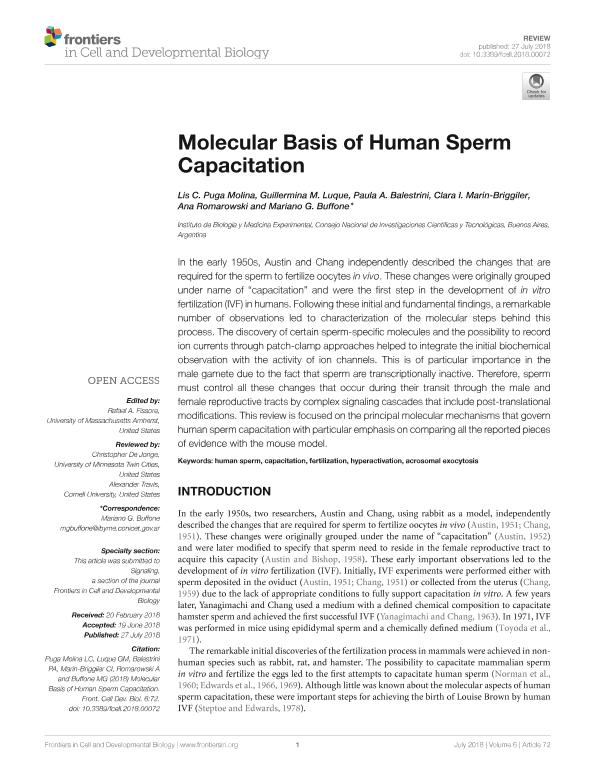Artículo
Molecular basis of human sperm capacitation
Puga Molina, Lis del Carmen ; Luque, Guillermina Maria
; Luque, Guillermina Maria ; Balestrini, Paula Ania
; Balestrini, Paula Ania ; Marin Briggiler, Clara Isabel
; Marin Briggiler, Clara Isabel ; Romarowski, Ana
; Romarowski, Ana ; Buffone, Mariano Gabriel
; Buffone, Mariano Gabriel
 ; Luque, Guillermina Maria
; Luque, Guillermina Maria ; Balestrini, Paula Ania
; Balestrini, Paula Ania ; Marin Briggiler, Clara Isabel
; Marin Briggiler, Clara Isabel ; Romarowski, Ana
; Romarowski, Ana ; Buffone, Mariano Gabriel
; Buffone, Mariano Gabriel
Fecha de publicación:
07/2018
Editorial:
Frontiers Media
Revista:
Frontiers in Cell and developmenta Biology
e-ISSN:
2296-634X
Idioma:
Inglés
Tipo de recurso:
Artículo publicado
Clasificación temática:
Resumen
In the early 1950s, Austin and Chang independently described the changes that are required for the sperm to fertilize oocytes in vivo. These changes were originally grouped under name of "capacitation" and were the first step in the development of in vitro fertilization (IVF) in humans. Following these initial and fundamental findings, a remarkable number of observations led to characterization of the molecular steps behind this process. The discovery of certain sperm-specific molecules and the possibility to record ion currents through patch-clamp approaches helped to integrate the initial biochemical observation with the activity of ion channels. This is of particular importance in the male gamete due to the fact that sperm are transcriptionally inactive. Therefore, sperm must control all these changes that occur during their transit through the male and female reproductive tracts by complex signaling cascades that include post-translational modifications. This review is focused on the principal molecular mechanisms that govern human sperm capacitation with particular emphasis on comparing all the reported pieces of evidence with the mouse model.
Palabras clave:
HUMAN SPERM
,
CAPACITATION
,
FERTILIZATION
,
HYPERACTIVATION
,
ACROSOMAL EXOCYTOSIS
Archivos asociados
Licencia
Identificadores
Colecciones
Articulos(IBYME)
Articulos de INST.DE BIOLOGIA Y MEDICINA EXPERIMENTAL (I)
Articulos de INST.DE BIOLOGIA Y MEDICINA EXPERIMENTAL (I)
Citación
Puga Molina, Lis del Carmen; Luque, Guillermina Maria; Balestrini, Paula Ania; Marin Briggiler, Clara Isabel; Romarowski, Ana; et al.; Molecular basis of human sperm capacitation; Frontiers Media; Frontiers in Cell and developmenta Biology; 6; 72; 7-2018; 1-23
Compartir
Altmétricas



